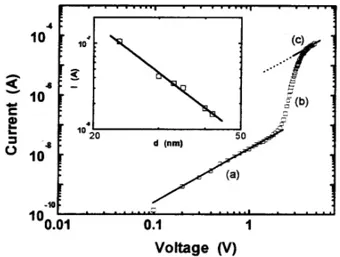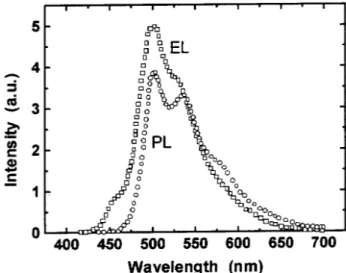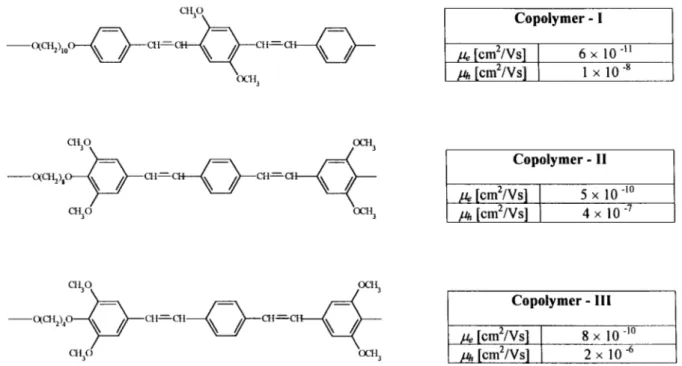Charge Carrier Mobility and Eletroluminesene in
a Green-Emitting Alternating Blok Copolymer
with a Methoxy Bi-Substituted Chromophore
Dongge Ma,I. A. Hummelgen
Departamento deFsia,
Universidade FederaldoParana,
CaixaPostal19081,81531-990 CuritibaPR,Brazil
Xiabin Jing, Daike Wang y
,Zhiyong Hong z
, LixiangWang, Xiaojiang Zhao,and FosongWang
ChanghunInstitute ofAppliedChemistry,
ChineseAademyofSienes,Changhun 130022, P.RChina
ReeivedFebruary,1998
We determine the mobility of positive and negative harge arriers in a soluble green-emitting
alternating blok opolymer with a methoxy bi-substituted onjugated segment. The negative
harge arrier mobility of 610 11
m 2
/V.s is diretly determined using spae-harge-limited
urrentanalytialexpressions. Positive hargearrier transportisalsospae-harge-limited,with
amobilityof110 8
m 2
/V.s. Theeletrontrapdistributionisexponential,withaharateristi
energy of 0.12 eV. A hole trap with energy0.4 eV was observed. This opolymer is used as
emissivematerialinorganilight-emittingdiodes thatpresent brightnessof900d/m 2
at12.5
V.
I Introdution
Asreentlyanalytiallydemonstrated, theharge
ar-riermobilityisaparameterthatplaysaruialrolein
the performane of pristine-semiondutor-
polymers-based light-emitting devies (LEDs) [1℄. The
distri-bution oftheemissiveregionoftheeletroluminesent
material in athin lm devie is diretlyontrolled by
thehargearriermobilities. Inmostof theasesthe
positivehargearriermobilityisuptoafewordersof
magnitudelargerthanthenegativehargearrier
mo-bility,onningthelightemissionregiontotheathode
neighborhood [2℄. Wider distributions would be
ob-servedwhentheratiobetweenthemobilityofpositive
andnegativehargearrierstendstoone[1℄.
ForLEDappliationsastrengthontrolofthe
emis-sion wavelength may beinteresting. The use of blok
opolymers permits to ontrol the emission in a way
similar to the variation of oligomer moleular mass,
but withoutlossoftheusefulmehanialpropertiesof
polymers. Inthis asethe opolymersare onstituted
by alternated bloks of onjugated (hromophor)and
non-onjugated (spaer)segments. Theemission olor
ontrol is ahievedby the ontrol ofthe length of the
onjugatedsegment[3,4℄.
Someof these eletroluminesent alternatingblok
opolymers present high photoluminesene eÆieny
in thesolidphase,whih wasattributed togreater
ex-itonionnementprovidedbytheblokopolymerby
virtue ofphase segregatedmorphology[5℄. One ould
expet thatthis harateristiassoiatedto awide
re-ombinationzoneinsidethepolymerlayerofaLEDalso
wouldimprovetheeletroluminesenteÆieny dueto
reduedeletrodequenhingofexitons. Toahievethe
ontrolthehargearriermobilitybymoleulardesign
is neessary to understand how the mobility is
inu-enedby severalof theopolymerharateristis suh
ashromophorelength,spaelengthandsubstitution.
The positive harge arrier mobilities observed in
aseriesofeletroluminesentalternatingblok
opoly-mers [6-9℄ is onsistentwith the fat that aredution
in the spaer length implies in a redution in the
Eletronimail:iahsia.ufpr.br
y
Presentaddress:DepartmentofPhysis,TheOhioStateUniversity,Columbus,Ohio43210-1106,USA.
erage tunneling distane, making harge transport by
hopping more faile. When the spaer is maintained
onstant, higher mobilities observed in polymers with
longer onjugated segments have been tentatively
ex-plained as being due to a higher onjugated material
to spaer material volume ratio, whih then redues
theaveragetunnelingdistane[6℄. Thenegativeharge
arriermobility hasagainanon-trivialdependene on
the spaerlength. It hasbeenobservedthat forshort
aliphatisegments(spaers)the energetidisorder
ex-pressedthroughtheharateristienergyoftheeletron
trapenergydistributioninthepolymersistemperature
dependent [9℄. Depending on temperature and spaer
length, the moleular fores responsible for the
ener-geti disorder an not morebe aommodatedby the
spaer, leading to a deeper trap distribution into the
gap [9℄.
Inthisontributionweinvestigatetheharge
trans-port harateristis of the eletroluminesent
alter-nating blok opolymer presented in Fig. 1 using
metal/polymer/metal devies. We demonstrate that
similarly toseveralotherorganimaterials[10-15℄and
speially, other eletroluminesent alternating blok
opolymers[6-9℄,eletronandholetransportis
spae-harge-limitedforthepolymerlayerthiknessused. We
determinethemobilitiesofpositiveandnegativeharge
arriers and investigate the appliation of this blok
opolymer as emissive layer in LEDs. The
theoret-ial bakground as well as the proedure adopted in
thisworkforthemobilityalulationissimilartothat
usedinearlierreports[6-9℄,permittingomparisonwith
othereletroluminesentalternatingblokopolymers.
Figure 1. Struture of the eletroluminesent alternating
blokopolymerinvestigatedinthiswork.
II Spae-harge-limited
trans-port
Fortheaseofexisteneofasingledisretesetof
shal-lowtrapsinsolids,atlowvoltages,eletrialondution
isohmiandtheurrentdensityisdesribedby[17℄,
j =q
eff n 0 V d ; (1)
where q is the eletroni harge,
eff
is the eetive
harge arrier mobility, d is the lm thikness, V is
the voltage, n
0
isthefreearrierdensity. As the
volt-Beauseoftheexisteneoftraps,theurrentdensityis
expressedas[17℄,
J = 9 8 V 2 d 3 ; (2) where = n
n+n
1
or = p
p+p
1
(3)
foreletronsandholes,respetively(nisthedensityof
freeeletrons,n
t
isthedensityoftrappedeletrons,pis
thedensityoffreeholesandp
t
isthedensityoftrapped
holes). Inthisase,
eff
(isthefreeharge
ar-riermobility). Taking the temperature dependene of
n, p, n
t , p
t
and onsequently of into aount,
eff
anbewritten intheform[9℄
eff = N N t exp E t E T ; (4)
yieldingastrongtemperaturedependene for
eff and leadingto j= 9 8 N N t exp E t E T V 2 d 3 : (5)
IntheexpressionsaboveN
isthedensityofstatesin
thevaleneband,N
t
isthedensityof traps,E
f isthe
relevantFermilevel,E
ismobilityedgeenergyfor
pos-itivehargesand E
t
is theenergylevelofthetraps;
istheBoltzmann onstant.
Todistinguish between(whih equals
eff when
1)and
eff
amoredetailedinvestigationinluding
temperature dependene of the urrent [see Eqs. (4)
and(5)℄mustbeperformed[6,9℄.
Inamorphousmaterialsasingledisreteenergylevel
mayno longerbeareasonableapproximation. In this
ase,theloalizedstates(traps)densityisexpeted to
beintheformofanexponentialdistributionatenergies
Ewithin theforbiddenenergygap,suhthat
h(E)= N t E exp E E ; (6) where E
is the harateristi energy of the
distribu-tion. Thej(V;d)dependeneinthisaseisoftheform
[17℄ j/ V m+1 d 2m+1 (7)
wheremT
=T;E
kT
(T istheabsolute
tempera-tureandT
istheharateristitemperature). Thus,if
j(V) is measuredfor dierent temperatures them(T)
urve an be onstruted and the value of E
anbe
determined(assuming atemperatureindependent E
) using: E =kT =k m T 1 (8)
someaseselddependentmobilitieswerealsoreported
forseveral organiompounds(see, forexample,Refs.
[10-12,18℄). As reently demonstrated[19℄, the
exper-imental j(V) urve annot be desribed for theentire
rangeofj(V)data takingthespae-hargeeets due
tolowhargearriermobilityintoaount,neitherfor
thePoole-Frenkelmodel[20℄,norforthehargedipole
interation model [21℄. The valuesobtainedusing the
high eld approximation expression due not oinide
withthatdeterminedwithhelpofEq.(2)whenthehigh
eldmobilityisextrapolatedtoE=0[19℄. Thevalues
determinedin thisworkusing theproeduredesribed
inthissetion,orrespondtotheeldindependent
mo-bilityase,whih isobservedatlowelds [19℄.
III Experimental
Themetal/polymer/metaldevies were preparedon a
glasssubstrate. Thebottommetaleletrodewasev
ap-oratedontotheglassandthepolymerwasspinoated
in CHCl
3
solution(5mg/ml)ontothis eletrode. The
topmetaleletrodewasthenevaporatedontothe
poly-merlayer. ThemetalsusedwereAlandAu,withwork
funtions () of 4.3 eV and 5.1 eV, respetively. The
polymer lm thikness was measured using a surfae
proler. Details onerning sample geometry were as
reported earlier [16℄. The urrent-voltage I(V)
mea-surements were made by inreasing the voltage from
zero to a maximum value at a rate of 0.1 V.s 1
and
thendereasingtozeroatthesamerate. Measurements
werearriedoutatroomtemperature,exeptwhenthe
temperature dependene wasdetermined. The
diele-trionstantofthepolymerwasassumedto be3.
LEDs were onstruted in an ITO/opolymer(d =
100 nm)/PMMA:PBD/Alq
3
/Al [ITO: indium-tin
ox-ide; PMMA: poly(methyl metharylate and PBD:
2-(4-biphenylyl)-5-(4-tert-butylphenyl)-1,3,4-oxadiazole;
Alq
3
: tris(8-quinolinolato)aluminum(d=8nm)℄LED
multilayer struture (see Ref. [22℄ for details). The
photoluminesene and theeletroluminesentspetra
were measured with a SPEX FL-2T2 spetrometer.
TheluminanewasmeasuredwithaalibratedST-900
luminanemeter.
IV Results
In Fig. 2 we present the I(V) (I: urrent; V:
ap-plied voltage) harateristis and I(d) (d:
opoly-mer layerthikness) dependene at onstant V foran
Au/opolymer/Aldevie, for Au positively biased. In
theI(V)urve,threeintervalsanbedistinguished: (a)
and() orrespondingtoj /V 2
; and(b)whih
orre-spondstoatrapllingregion[6,9℄wherethevalueof,
and onsequently,
eff
hangesabruptly. This I(V;d)
Figure2. I(V) harateristis ofanAu/opolymer/Al
de-vie(d=40nm)forAupositivelybiased. Inset: I(d;V =
1V)dependeneforsampleswithdierentthikness.
ApplyingEq. (2) to the data of segments(a) and
() of Fig. 2 (15 samples) leads to
eff
equal to
(1:30:3)10 10
m 2
/V.sand to (1:40:3)10 8
m 2
/V.s, respetively. The hange in the
eff value
onrms that segment (b) orresponds to trap lling.
Fromtheinsetof Fig. 2itis possibleto observethat,
takingtheI(V)datafromsampleswithdierent
thik-ness, for V = 1V, logI
logd
3; just as also expeted
fromEq. (2).
In Fig. 3 we present the I(V) harateristis of
anAu/opolymer/Aldeviefordierenttemperatures.
Themeasuredrangeorrespondstosegment(a)inFig.
2. Intheinset,wepresentthetemperaturedependene
of
eff
. Using Eq. (4), 0.4 eV was determined. The
I(V)urveisalmosttemperatureindependentfor
volt-ageslargerthanthetrapllingvoltage.
Figure3. I(V) harateristis ofanAu/opolymer/Al
de-vie(d=30nm)atdierenttemperatures(diamonds: 229
K;triangles: 250K;irles: 275K;squares:293K) forAu
positivelybiased. Inset: Temperaturedependeneofeff.
In Fig. 4 we present the I(V) harateristis of
an Al/opolymer/Aldevie. This I(V) urveis
har-aterized by three distint segments: (a) ohmi, i.e.,
j / V m+1
=d 2m+1
and; () j / V 2
. In the inset of
Fig. 4, we present the V(d 2
), where V(I =110 8
A) was taken for dierent samples (with dierent d).
Form>2;V isexpetedtobeapproximately
propor-tionaltod 2
[seeEq. (7)℄ifthetransportisspae-harge
limitedduetoanexponentialdistributionoftraps.
Ap-plying Eq. (2) to the segment () of the I(V) urves
of 14samples,weobtained
eff
=(5:92:3)10 11
m 2
/V.s.
Figure 4. I(V) harateristis of anAl/opolymer/Al
de-vie(d=44nm).Inset: V(d 2
;I=110 8
A)dependene
for sampleswithdierentthikness.
In Fig. 5, I(V) urves taken at dierent
temper-atures using Al/opolymer/Al devies are presented
(the voltagerangewaslimitedto avoidpossibledevie
degradation). The values m(T) were determined and
E
C
' 0:12 eV alulated using Eq. (8). The m(T)
dataarepresentedin theinsetofFig. 5.
Figure 5. I(V) harateristis of anAl/opolymer/Al
de-vie(d=40nm)atdierenttemperatures(diamonds: 154
K;irles: 194K;triangles:292K).Inset: m asafuntion
ofT 1
.
In Fig. 6 the photoluminesene (PL)
spetrum of the opolymer is ompared with
ITO/opolymer/PMMA:PBD/Alq3/Al LED. In Fig.
7 we ompare the urrent and the brightness
evolution with inreased applied voltage for the
ITO/opolymer/PMMA:PBD/Alq3/AlLED.
Figure 6. Photoluminesene spetrum of the opolymer
is ompared with the eletroluminesene spetrum of an
ITO/opolymer/PMMA:PBD/Alq3/AlLED.
Figure 7. Comparison of the urrent and the
bright-ness evolution with inreased applied voltage for the
ITO/opolymer/PMMA:PBD/Alq3/AlLED.
V Disussion
The I(V) urve presented in Fig. 2 is obtained
us-inganAu/opolymer/Aldevie. Consideringthework
funtions of the eletrodes and the fat that the
val-uesofionizationpotentialofthehromophoresare
ex-petedtobeneartothoseobservedin PPVoligomers,
thehargetransport is predominantly due to positive
hargearriers. The
eff
valuesdeterminedusingthese
dependentbeforetraplling[segment(a)inFig. 2℄and
almosttemperatureindependentforlargervoltages,the
valuedeterminedfromsegment()orrespondstothe
freepositivehargearrier(1).
The urrent in Fig. 5 also arrives a region
[seg-ment()ofFig. 4℄whereitbeomestemperature
inde-pendent. Consequently,thehargearriermobility
ex-tratedfrom thissegmentistemperatureindependent,
indiatingthatalltraplevelsarefull(1).
Consider-ingthatthismobilityvalueislowerthanthoseobserved
inAu/opolymer/Aldevies,itisattributedtoanother
typeofhargearrier,i.e., tonegativehargearriers.
In Fig. 8 we ompare the reported harge arrier
mobilitiesfordierenteletroluminesentblok
opoly-mers [6,8,9℄. Inthe series of polymers theonjugated
segments are of the same length, with spaers of
de-reasinglength. AsshowninFig. 8,both,thenegative
harge arriermobilityand thepositivehargearrier
mobilityinreasewithdereasingspaerlength.
Figure8. Comparisonofthepositive(
h
)andnegative(e)hargearriermobilitiesfordierentblokopolymersreently
investigated.
Theharateristienergyoftheeletrontrap
distri-bution of opolymerI (0.12eV)is signiantlyhigher
than observed in opolymers II and III [0.06 eV and
0.05eV(atroomtemperature),respetively℄. Polymer
I hasthelongestspaer,sothatitshould beexpeted
thatitwouldbeabletoaommodatetensionsand
re-duetheenergetidisorder,ontrarilythan
experimen-tally observed. This disagreement may suggest that
the methoxy groupspresent in theentral ringof the
hromophore in thisopolymerare responsibleforthe
inreaseintheenergetidisorder.
It has been observed that
poly(2-methoxy-p-phenylene vinylene), MeO-PPV, presents a lower
de-gree of strutural order than PPV and
poly(2,5-dimethoxy-p- phenylene vinylene), DMeO-PPV [26℄.
This fat was attributed to the opolymer struture
stitution. Thisobservationmaybepartiallyappliedto
opolymerI. Evenfor aplanar hromophore,two
dif-ferent ongurations of the hromophore are possible
due to rotation of the entral ring, leading to
dier-entpossibleinterationsbetweenneighboringmoleular
segments,inreasingenergetidisorder.
CopolymerI isgreen-emitting (seeFig. 6)
indiat-ing that the methoxy bi- substitution in the entral
ring of the hromophore produes a red-shift in the
eletroluminesent spetrum. Copolymers II and III
areblue-emittingandthenon-substitutedanalogueof
opolymer I has an emission maximum near 470 nm
[23℄. Ithasbeenobservedthatboth,theabsorptionand
the emission spetraof eletroluminesent alternating
blokopolymersaredeterminedbytheirhromophori
with shorter spaer, but with the same hromophori
unit[25℄,havesimilaremissionspetra,whihonrms
that the red- shift is due to the introdued methoxy
groups.
LEDsonstrutedwithananalogueopolymerwith
shorter spaer have presented higher EL intensity as
well aslowerthreshold voltage for lightemission [25℄.
This maybeattributed in partto thehigher mobility
expetedfortheopolymerwithshorterspaer,
indiat-ingthatfromthehargetransportpointofview
opoly-mers with shorterspaers (but longenoughto permit
aommodationofforesthatwouldpromoteenergeti
disorder) aremostappropriateforLEDappliations.
VI Conlusion
Weinvestigatethetransportharateristisofan
ele-troluminesent alternating blok opolymer with a
methoxy bi-substituted hromophore and determine
the mobility of positive and negative harge arriers
in thispolymer.
We observed that the methoxy substitution
pro-dues, when this polymeris ompared withanalogues
with the same onjugated segment length, a red-shift
in theemission spetra. Thehargearriermobilities
in this polymer are lower thanthat observedin other
blokopolymerswithonjugatedsegmentsofthesame
length,but withshorterspaers.
LEDs onstruted using this blok opolymer as
emissivematerialpresentabrightnessof 900d/m 2
whenoperatingat 12.5V.
Aknowledgements
The authors would like to thank CNPq and
PADCT/CNPq(Projet62.0081/97-0CEMAT)for
-nanial support. X. J., L. W. and F. W. thank the
nanialsupport fromNNSFandCASF.
Referenes
[1℄ M. Koehler, M. G. E da Luz and I. A. Hummelgen,
submittedtoPhys.Rev.B.
[2℄ J.Gruner,M.RemmersandD.Neher,Adv.Mater.9,
964(1997).
[3℄ Z. Yang,I.SokolikandF.E.Karasz, Maromoleules
26,1188(1996).
[4℄ R.M.Gurge,M.Hikl,G.Krause,P.M.Lathi,B.Hu,
Z.YangandF.E.Karasz,Polym.Adv.Tehnol.9,504
(1998).
[5℄ B.HuandF.E.Karasz,Synth.Met.92,157(1998).
[6℄ Ma Dongge, I. A. Hummelgen, Bin Hu, and F. E.
Karasz,J.Appl.Phys.86,3181 (1999).
[7℄ DonggeMa,I.A. Hummelgen,Bin Hu,F.E.Karasz,
J.Phys.D:Appl.Phys.32,2568 (1999).
[8℄ DonggeMa,I.A. Hummelgen,Bin Hu,F.E.Karasz,
Xiabing Jing, Lixiang Wang and Fosong Wang, Sol.
Stat.Comm.112,251(1999).
[9℄ DonggeMa,I.A. Hummelgen,Bin Hu,F.E.Karasz,
Xiabing Jing, Zhiyong Hong, Lixiang Wang,
Xiao-jiangZhao,andFosongWang,J.Appl.Phys.,87,312
(2000).
[10℄ D.M.Pai,J.F.JanusandM.Stolka,J.Phys.Chem.
88,4714(1984).
[11℄ B.M. Abkowitz, H.Bassler andM.Stolka,Phil.Mag
B63,201(1991).
[12℄ L.B.Shein,Phil.Mag.B65,795(1992).
[13℄ P. E. Burrows, Z. Shen, V. Bulovi, D. M. MCarty,
R.S.Forrest, J.A. Cronin, and M. E.Thompson, J.
App.Phys.79,7991(1996).
[14℄ A.J. Campbell, D. D. C.Bradley,and D. G.Lidzey,
J.App.Phys.82,6326 (1997).
[15℄ P.W.M. Blom,M. J.M.deJong,andJ.J.M.
Vleg-gaar,Appl.Phys.Lett.68,3308 (1996).
[16℄ L.S.Roman,I.A.Hummelgen,F.C.Nart,L.O.Peres
eE.L.deSa,J.Chem.Phys.105,10614(1996).
[17℄ EletrialTransport in Solids, K. C. Cao and W.
Hwang, Pergamon,1981.
[18℄ L.Bozano, S.A.Carter, J.C.Sott, G.G.Malliaras
andP.J.Brok,Appl.Phys.Lett.74,1132(1999).
[19℄ J.A.Freire,DonggeMaandI.A.Hummelgen,Organi
Eletronis,submitted.
[20℄ J.Frenkel,Phys.Rev.54,647(1938).
[21℄ D. H. Dunlap, P.E. Parris and V. E. Kenkre, Phys.
Rev.Lett.77,542(1996).
[22℄ Ma Dongge, Zhao Xiaojiang, Hong Zhiyong, Wang
Daike,JingXiabinandWangFosong,SieneinChina
B41,272(1998).
[23℄ Z.Yang, B.Huand F.E. Karasz, J. Maromol.Si.,
PureAppl.Chem.,A35,233(1998).
[24℄ Bin Hu, F. E. Karasz, D. C. Morton, I. Sokolik and
ZhouYang,J.Lumines.60&61,919(1994).
[25℄ Q.Zheng,R. Sun,T. Kobayashi,Z. Hong,D. Wang,
X.Jing,F.Wang,N.Minami,K.YaseandT.Masuda,
Synth.Met.97,13(1998).
[26℄ W.B.Liang,M.A. MasseandF.E.Karasz, Polymer


